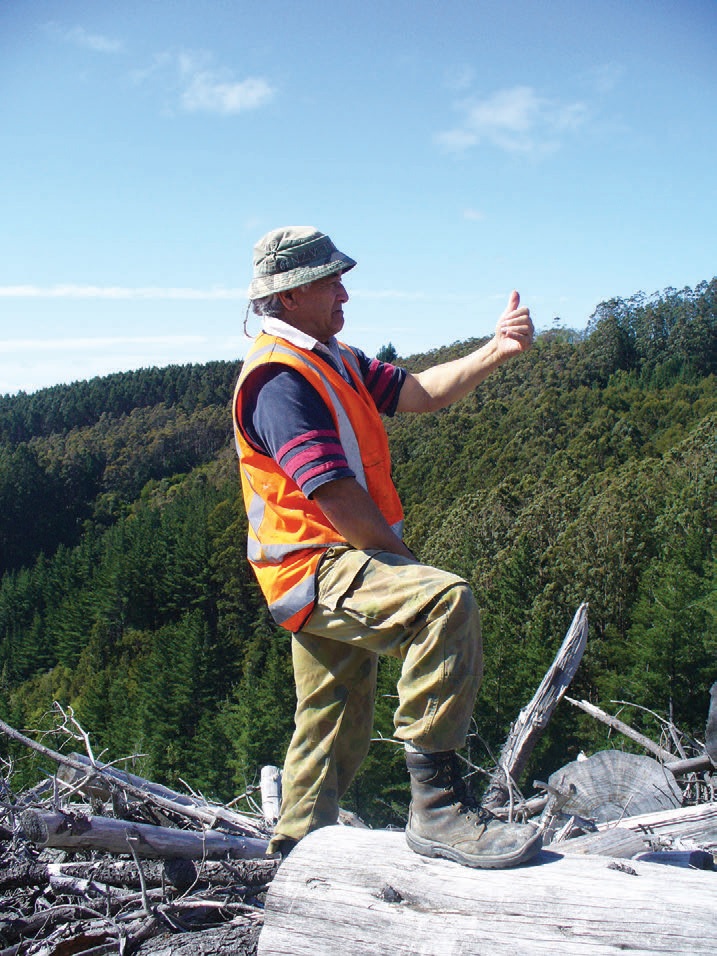A visit to Manutahi Forest
Rodney Faulkner, New Zealand Tree Grower November 2009.
The small East Coast township of Ruatoria has faced many threats over the years. As a service centre for the surrounding farming community it has been affected by the fortunes of the market place, as has the rest of the country. However, those who visited the area at the last conference saw the fragility of the geology on the East Coast has had a major economic effect on the various communities in the area.
Forestry centre
When livestock farming became less viable on the severely eroding areas, large scale forestry became the major employer in the district. From the mid 1960s townships such as Ruatoria became the centres for the NZ Forest Service planting programme on the East Coast. Pastoral farming had been viable for less than 100 years and it was obvious that some of the land should have never been cleared.
The township is built on a shingle fan at the foot of a large hill which contains several eroding gullies, one of which regularly blocked the only road access. Another threatened the schools and marae as well as the residential area. In 1971, to lessen the threat to the township, the Forest Service bought all 11 properties in the catchment area with the aim of establishing a managed protection forest.
Alternative species
The Gisborne/East Coast Branch had a field day at the Manutahi Forest recently and were guided through the block by Willis Hapi who has been involved with the forest from planting to the present day. Also on hand were Bill Wheeler, general manager of Ngati Porou Whanui Forests Ltd, and Randolph Hambling, MAF regional manager.
At the time of planting the Forest Service policy was to plant at least five per cent of the forest area in species other than radiata. In the case of this forest over 60 per cent was planted in alternative species, to provide a more aesthetic backdrop to the township and to provide recreational activities to the community.
Nearly 80 hectares of the forest was planted in radiata at 2,000 stems per hectare, pruned and thinned to 300 stems per hectare. Much of this was harvested a couple of years ago and yielded approximately 26,000 tonnes. The area has since been replanted in radiata with a small gully at one end planted in Eucalyptus muelleriana, with poplar poles planted along erosion prone stream banks.
The rest of the block is planted in a variety of species. There are 20 hectares of E. saligna and 33 hectares of a mix of E.regnans, E. delegatensis and E.fastigata, all growing very well and an indication of the suitability of the species for the East Coast region. There is a 20 hectare block of redwood planted in light wells in the existing kanuka which they have now suppressed totally.

A small block of kauri, rather pessimistically planted in groups of three, almost all of which have survived, would greatly benefit from some reduction of the existing kanuka. This appears to be having an affect on growth rates. Kauri obviously grows well in this area although it is a long way from its natural habitat.
Other species include macrocarpa, lusitanica and western red cedar, with a small area of bottle brush, proving that even foresters have a sense of humour. There is range of planted indigenous species such as totara, matai, rimu and kahikatea as well as natural regeneration.
The Manutahi Forest has indeed protected the Ruatoria township site. While the aesthetic value of a mixed planting is evident, the recreational potential has yet to be developed.
The growing conditions on the East Coast suit a wide range of species with fertile soils, mild temperatures and adequate rainfall ensuring very good growth rates. Land tenure is sometimes an issue with multiple ownership affecting management decisions. However, in this case, the Crown has been working through a process to contact the original owners, the majority of whom are Maori. Discussions on the future tenure of the land still have a long way to go.
It is becoming increasingly evident that the economics of growing a relatively low value timber such as radiata in a forest that is three hours from a processing mill are marginal. It is also obvious that in order for some of the alternative species grown here to reach their potential they require at least as much management as conventional radiata. It seems short sighted to plant a forest such as this and not allow for the necessary silvicultural work.
Many of the species grown could provide a very valuable resource for a small scale commercial operation, particularly in an area with high unemployment. This could surely be managed without destroying the protection values of the forest. Well managed selective extraction coupled with an efficient on site processing facility and possibly even an end use business could add greatly to a community such as this.

 Farm Forestry New Zealand
Farm Forestry New Zealand